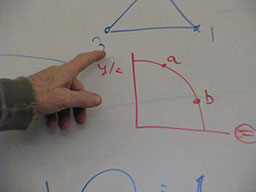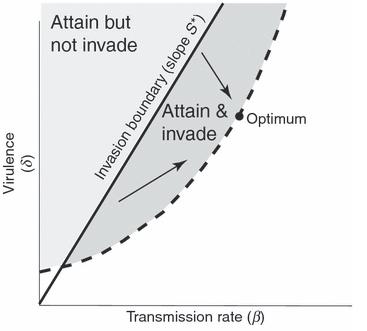While I'm not that big a fan of the project trying to find commonalities between economics and biology, largely because I think explanations of specific phenomena often reduce to those stupid fucking natural history facts, I was struck by this argument by economist Samuel Bowles about the assumption of optimality in the supposed tradeoff between income equality and economic output (italics mine):
Theoryland may be the only place the "equality-efficiency trade-off" really works. Just to prove it wrong, Bowles charts the concept on a whiteboard at SFI.
The vertical axis is economic output. The horizontal axis is equality. The curve shows the theoretical trade-off. "So we're here"--point A, high on the curve--"and we want to go to point B because we're egalitarian. And [the theory says] that's kind of too bad because we're going to suffer the loss of income," he says.
Bowles draws another dot inside the curve--point C--symbolically destroying the clean, simple world represented by the model. "Basically, it assumes that the economy is already efficiently organized," Bowles explains. "But most economies are at point C. They have both more inequality and less income than they could have because they're inefficient."
And there's a picture:

The reason I bring this up is because this picture is remarkably similar to this one:

This image has to do with the tradeoff between virulence and transmission in viral evolution. Basically, the argument goes that the virus will evolve to optimize the relationship between virulence and the ability to spread to a new host. If the virus is too deadly (virulent), it will kill the host before it can spread. If it's not virulent enough, then the virus suffers since it hasn't produced as many infectious particles as it could have. This leads some to publicly claim that influenza isn't a problem, since it will evolve to lower virulence. But this assumes that the virus is already optimized to live in people, as shown the above figure.
But there's no reason to think that a virus living in pigs (TEH SWINEY FLOO!!) has reached an optimum in humans. Instead it is at a suboptimal point:
In this figure, the virus starts in the dark grey zone and moves towards the dot representing the optimum. If the virus starts at the top arrow, it will decrease in virulence (a good thing). But if it started at the lower arrow, it would actually become more virulent (a very bad thing).
If you flip Bowles' figure 180 degrees, his "dot inside the curve--point C" is the same as the line representing the viral suboptimal starting point ("invasion boundary").
Assuming optimality isn't a bad thing as a theoretical exercise--that is, if we assume X, then Y happens. It's very useful in developing frameworks and intellectual tools. But when you're either trying to predict the likelihood that something specific will happen or explain why something did happen, assumptions are very important. They can't be glossed over. And optimality (or even near optimality) is a very difficult criterion to meet. If your prediction relies on that assumption, you stand a good chance of being in trouble.
- Log in to post comments

Assuming optimality is actually rather foolish because it makes it harder to recognize growth or decline and the forces behind them. If you assume a system is at some optimal point, it can only change by expanding the model to include stuff you left out. If you assume a system is not at its optimal point, then it is quite possible that your model may describe its evolution. Why choose a model that doesn't provide insight, unless, of course, you aren't looking for insight.